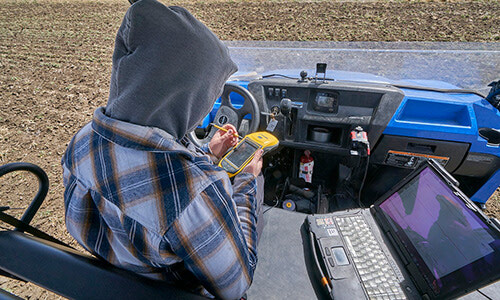Our In-Season Soil Conductivity study is wrapped up ≥ now we wait for the data!
For the past two years, we've been looking at a field-scale precision approach to evaluate soil moisture and nitrogen management. Our study took place in 160-acre fields, we utilized both dryland and irrigated sites. We tested with fields that grew seed alfalfa, peas, wheat, and canola.
Our goal was to measure real-time soil parameters in a non-destructive and non-invasive manner. By accomplishing this, we can help farmers optimize their practices with this new tool for moisture management.
The EM-38 Soil Conductivity Sensor
When it comes to moisture management, farmers don't have many tools. If you're debating irrigating a field you can place some probes in your field, collect samples, but you might not get the whole picture. We want to be able to map out the entire field and understand where moisture is at its highest and lowest points.
"When we first started, we wanted to evaluate two things - first, does it even work? Second, does it make sense to use this tool?" said Lewis Baarda, manager of Farming Smarter's Field Tested program.
In the field, the EM-38 soil conductivity sensor is low-contact and low-disturbance which makes it easy to use with minimal disturbance to your crops. We attached it to a quad and could drive it through the field with ease.
Throughout the study, we mapped the fields every few weeks during spring to see what changes occurred in the soil's moisture.
Conducting Early Results
While the data is still being analyzed, we can share our preliminary findings!
In our efforts to come up with an accurate moisture map, we mapped the fields every few weeks throughout spring. We found out that we may have been overdoing it!
"We mapped the fields the day we seeded, a few days after, and a month later ≥ at this point the crops had grown too tall to be able to pass through without risking damage," said Baarda. "When we came back a few weeks after our first pass, we didn't see much difference in our moisture maps."
The biggest benefit we found was being able to see the moisture levels throughout the field before we applied any water. This alone makes a soil conductivity sensor a great asset for farmers.
Measuring where the moisture is allowed us to better understand our field. Crops need moisture to take up nitrogen, more moisture means more nitrogen. However, moisture in a field isn't exactly linear ≥ there are spots with high moisture levels and others with low moisture levels.
Once mapped, we were able to optimize our fertilizer application to the field. Fertilizer doesn't get used in dryland crops if there's little moisture, so knowing how much moisture is in your field is important!
If you want to learn more about the In-Season Soil Conductivity study, buy a ticket to our 2022 Conference & Trade show, February 16 & 17 where Lewis Baarda will be presenting the final results of the study!

